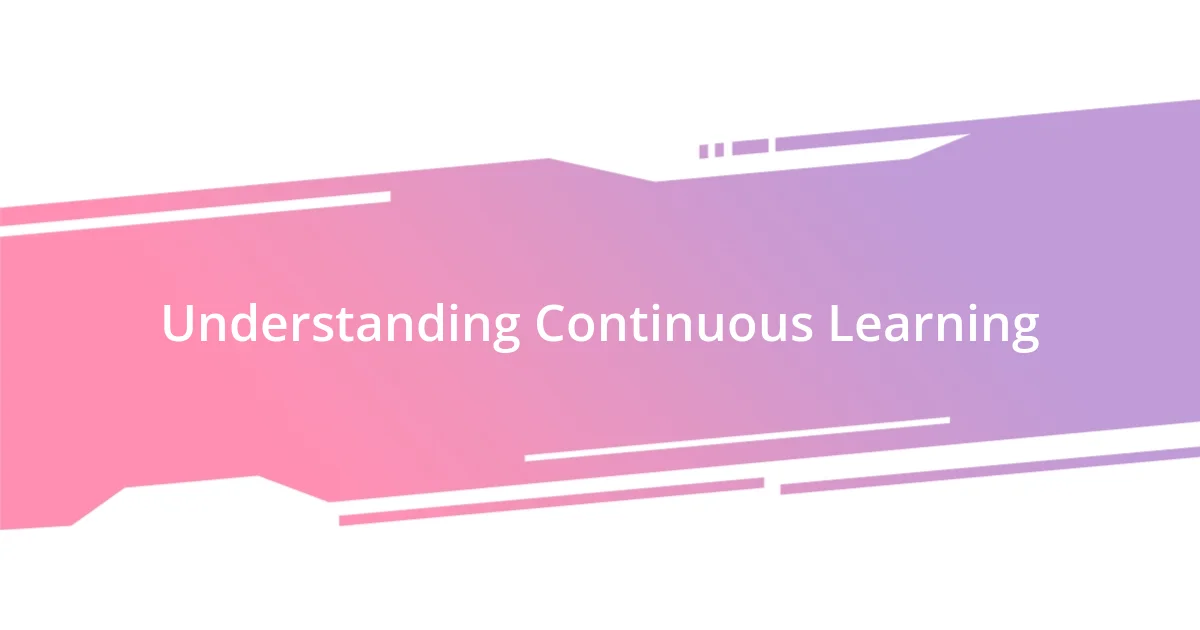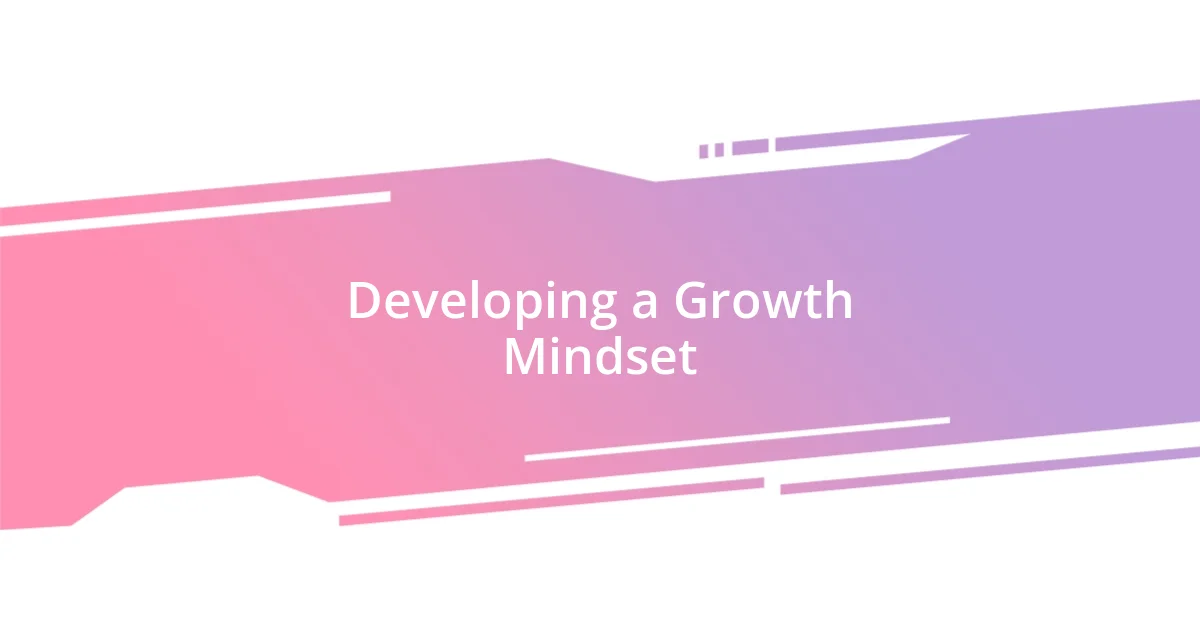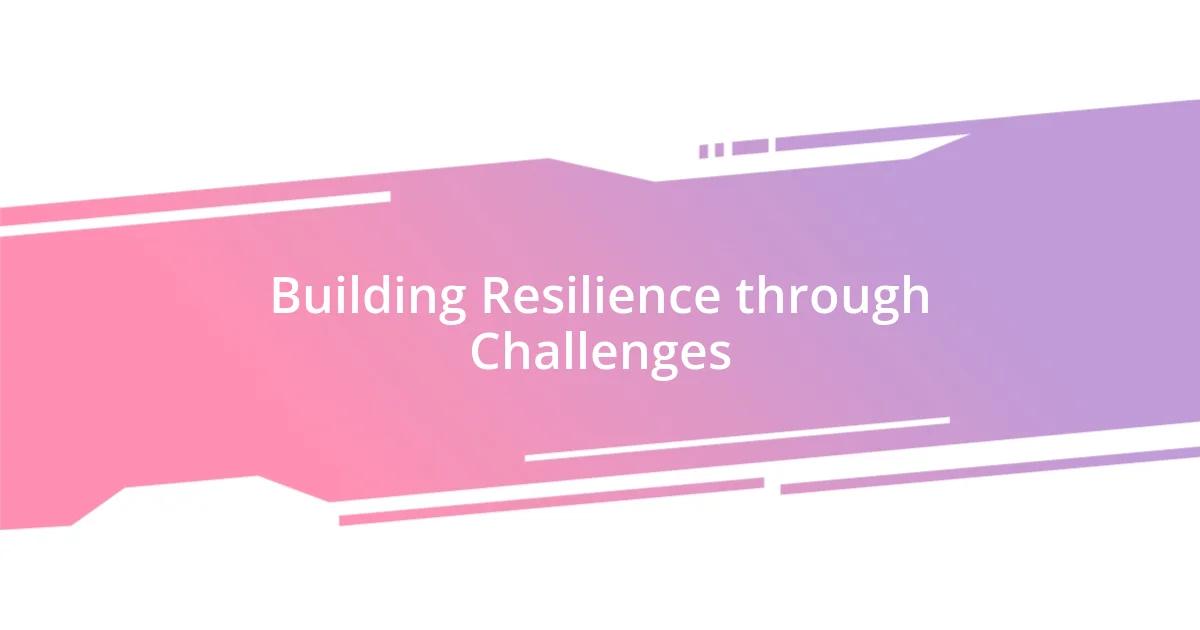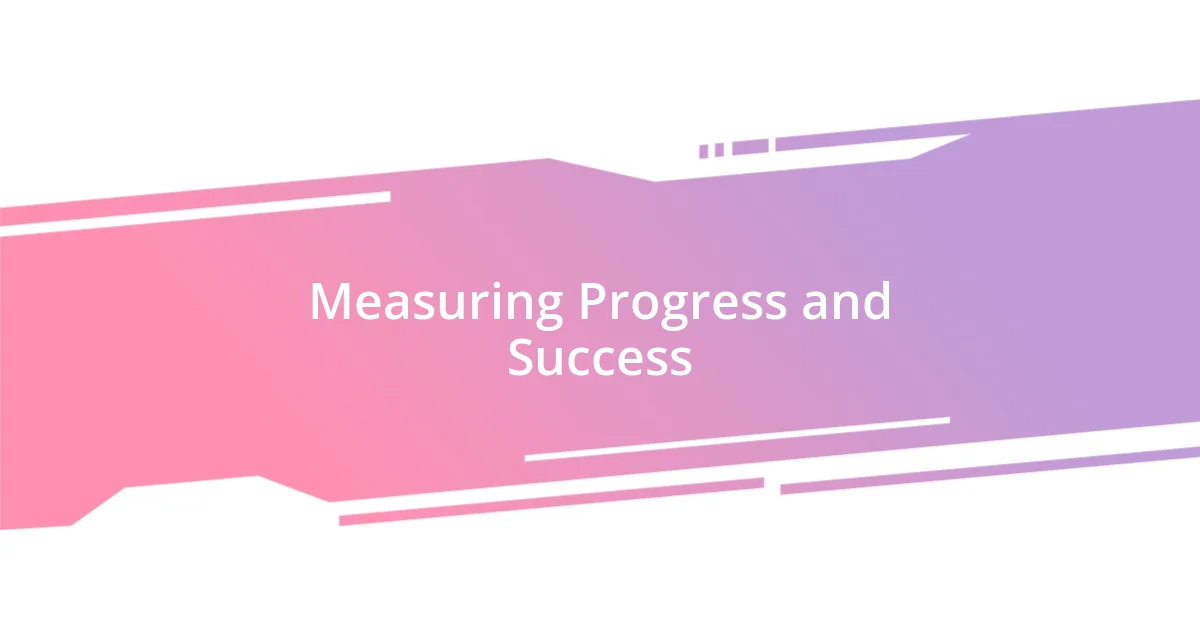Key takeaways:
- Continuous learning is a lifelong journey, requiring openness to feedback and transformation of failures into learning opportunities.
- Elite athletes exemplify dedication, resilience, and the importance of teamwork, teaching us valuable lessons applicable to personal and professional growth.
- Building a growth mindset involves reframing challenges as opportunities, setting clear goals, and measuring success through incremental progress rather than just final outcomes.

Understanding Continuous Learning
Continuous learning is a mindset that transcends formal education. It’s about embracing the idea that growth doesn’t stop after school; it’s a lifelong journey. I remember a time when I challenged myself to learn a new sport. Each practice session revealed not just techniques but insights about perseverance, adaptability, and even community.
Consider how athletes view failure—not as an endpoint, but as a stepping stone. When I watched a friend miss a crucial shot during a game, it struck me how he turned that moment into a learning opportunity. He didn’t sulk; instead, he dissected his performance, asking, “What can I do better next time?” This kind of reflection is vital. Isn’t it fascinating how each setback can ignite a new path of understanding?
Engaging with continuous learning means being open to feedback and seeking knowledge from various sources. I once attended a workshop led by an elite coach who shared lessons from his years of experience. His stories were rich with emotion and rooted in real-life examples. The tears and triumphs he recounted made me realize that learning is often intertwined with our feelings. What did that experience teach me? That every interaction offers a chance to grow, if we are willing to embrace it.

Lessons from Elite Athletes
Elite athletes teach us invaluable lessons about dedication and resilience. I vividly recall watching a documentary on a marathon runner who trained relentlessly for months. The moment he crossed the finish line, despite the physical pain and exhaustion on his face, I felt a rush of inspiration. He had pushed through barriers many would consider insurmountable. That’s when I realized: grit and determination can transform a dream into reality.
Here are some key lessons I’ve gleaned from watching elite athletes overcome challenges:
- Embrace Discipline: They stick to rigorous training regimens, teaching us the importance of structure and commitment.
- Focus on Improvement: Every practice isn’t just about performance; it’s about refining techniques and strategies.
- Manage Pressure: They cultivate mental fortitude, showing us how to stay calm and focused under stress.
- Value Teamwork: Many elite athletes emphasize collaboration, reminding us that great achievements often require support and camaraderie.
- Seek Continuous Feedback: They actively pursue insights from coaches and peers, demonstrating that learning is an ongoing process.
Every encounter with their stories leaves me more aware of the lessons hidden in both triumphs and setbacks. It’s a powerful reminder that growth often comes from pushing our limits.

Developing a Growth Mindset
Embracing a growth mindset is fundamentally about believing in the capacity for improvement. I recall a moment during my early days in sports when I struggled with a particular skill. I felt overwhelmed and frustrated, but then I remembered an athlete’s advice: “It’s not about being the best. It’s about being better than you were yesterday.” That perspective shift changed everything for me. Rather than focusing solely on my failures, I began to relish the process of learning itself.
When you look at athletes, their journey often embodies resilience and persistence. Take, for example, a basketball player who, after missing a last-minute shot, spends extra hours refining her shooting technique. Rather than dwell on the missed opportunity, she uses it as fuel for her improvement. I’ve found that this mentality is exhilarating! Every small triumph or setback can be reframed as a lesson, teaching us to embrace challenges as stepping stones.
Incorporating a growth mindset involves actively seeking challenges and welcoming feedback, much like an athlete receiving coaching. I remember attending a sports workshop where the audience was encouraged to share their failures openly. The stories that emerged were raw and emotional, creating a sense of camaraderie. This openness allowed everyone to cultivate mutual growth. Isn’t it powerful to realize that sharing our vulnerabilities can be a source of strength? That’s the essence of a growth mindset—transforming fear into motivation.
| Growth Mindset | Fixed Mindset |
|---|---|
| Embraces challenges | Avoids challenges |
| Sees failure as a learning opportunity | Sees failure as a reflection of ability |
| Values effort and persistence | Believes talent alone leads to success |
| Welcomes feedback and criticism | Feels threatened by feedback |
| Celebrates the success of others | Feels threatened by others’ success |

Applying Athlete Strategies in Life
Elite athletes have a remarkable ability to approach challenges that can be translated into our everyday lives. I remember setting a challenging goal for myself at work; it felt monumental. Just like an athlete getting ready for a competition, I mapped out a plan and held myself to a discipline I had never practiced in my professional life. Embracing that level of commitment and structure taught me that we can unlock our potential through consistent effort, much like those rigorous training schedules athletes follow.
One lesson that stands out to me is the way athletes handle setbacks. I once watched a tennis match where a player lost a critical point, yet instead of sulking, he channeled his frustration into his next serve. This moment resonated deeply with me during my own experiences. Have you ever faced a setback and felt like giving up? I certainly have. Learning to view those moments as opportunities for growth has transformed my perspective. Instead of viewing failure as a dead end, I find it’s a chance to develop resilience and come back stronger, just like that tennis player.
Finally, the emphasis on teamwork strikes a chord within me. Participating in group projects often felt daunting, but an experience during a team sports event changed my outlook. I recall a moment when our group was losing; we had to come together, share strategies, and lift one another emotionally. It wasn’t just the victory that mattered, but the connections we formed during that time of struggle. Athletes understand that triumphs are rarely solo ventures. Realizing that support and collaboration amplify our strengths urges us to seek out partners in both our personal and professional lives. Isn’t it fascinating how much we can learn from the world of sports?

Building Resilience through Challenges
The journey of resilience is often paved with obstacles. I remember a particularly tough training session that pushed my limits. I felt like throwing in the towel, but then I recalled what my coach used to say: “Every champion was once a contender that refused to give up.” That framing made me realize that enduring those toughest moments is where true growth happens. It’s in those moments of struggle that we dig deep and uncover our strength.
Challenges can be daunting, but I’ve learned to embrace them as vital teachers. Once, during a crucial game, I made a catastrophic error that cost us points. Initially, the disappointment was overwhelming. But then, as I replayed the moment in my mind, I recognized that this experience provided invaluable lessons. It forced me to analyze what went wrong and ultimately fueled my drive to improve. I’ve come to understand that our perceived failures are often the moments that illuminate the path to resilience.
Furthermore, I often reflect on the importance of shifting our perspective. I once attended a motivational speech by an athlete who had faced severe injuries throughout his career. He spoke about how each setback allowed him to return stronger and more determined. His story resonated with me on a profound level. Isn’t it remarkable how reframing a challenge as an opportunity can redefine our journey? That’s the essence of building resilience—not just surviving adversity, but thriving because of it.

Creating a Personal Development Plan
Creating a personal development plan can feel overwhelming, but I’ve discovered it starts with clear goals. When I first set out to improve my skills, I wrote down exactly what I wanted to accomplish, whether it was enhancing my communication skills or increasing my physical fitness. That acted like a lighthouse in a storm, guiding me through the chaos of daily life.
I also found it incredibly useful to break those goals down into actionable steps. For example, instead of just saying I wanted to be fit, I decided to incorporate two workouts a week and explore new activities like yoga and hiking. Reflecting on those small victories not only bolstered my motivation but also made the process enjoyable. What seems achievable often lies in taking consistent, bite-sized steps that add up over time.
Tracking progress has been a game-changer for me as well. I remember the first time I completed a month of my personal development plan—I felt a rush of accomplishment. Keeping a journal to document what I’ve learned and the changes I’ve noticed keeps me connected to my journey. Have you ever reflected on how much you’ve grown? It’s those moments of reflection that remind me of the strides I’ve made and inspire me to keep pushing forward.

Measuring Progress and Success
Measuring progress and success can often feel elusive, but I’ve learned to embrace meaningful metrics. Early in my journey, I focused solely on final outcomes—like winning competitions—only to feel disheartened when those results didn’t align with my expectations. Over time, I discovered that celebrating small triumphs, like mastering a new technique or achieving personal-best times in training, offered a more rewarding perspective. Isn’t it fascinating how the little things can shape our overall experience?
I vividly recall a time when I set out to improve my endurance. Instead of fixating on race day results, I began tracking my training sessions diligently. Every time I ran a few extra laps or pushed through a tough workout, it felt like a win. I kept a chart on my wall, marking my progress; each notation became a testament to my hard work. Seeing that visual representation transformed my view of success, making it about consistent effort rather than just the end result.
Reflecting on my experience, I also understand how crucial it is to adapt measures of success to my personal journey. I once met an athlete whose primary goal wasn’t winning but fostering a love for the sport in younger players. This shift in focus allowed her to measure success in different ways—by the joy she spread and the growth she enabled in others. Could it be that redefining our personal metrics of success engages us more deeply in our pursuits? That realization has empowered me to align my motivations more closely with my values, creating a more fulfilling path forward.














